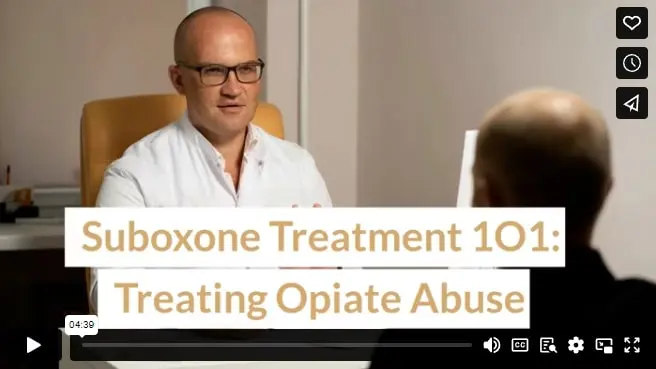The first and probably most important thing you need to know about Suboxone is that it saves lives. That said, the second thing to understand is that Suboxone is not a cure for opioid addiction, namely in that it is, itself, an opioid.
Suboxone is but one form of medication-assisted treatment (MAT) for opioid abuse. Other medications used in treating opioid disorders include methadone and naltrexone. Many substance abuse rehabs use MAT to help people with opioid use disorders detox and control cravings.
A person with an OUD typically will have an addiction to one or more of these common opioids: Oxycodone, hydrocodone, methadone, morphine, fentanyl, or heroin.
“Although we believe that therapy is the core aspect of recovery treatment, medication-assisted treatment has an important role to play,” explained Preston Dixon, COO at Renaissance Ranch, a men’s treatment center with facilities in Utah and Idaho. “Like any drug, though, it’s not a good fit for everyone. That’s why we have highly-experienced medical staff to work with our clients in developing an individualized plan that best suits their needs.”

(Alex Green/Pexels)
What Is Suboxone and How Does It Work?
Suboxone is a combination of two drugs – buprenorphine and naloxone. Opioids like morphine and oxycodone are known as potent ‘agonists.’ Agonist opioids block the pain receptors in the brain and produce a euphoric effect. Buprenorphine, on the other hand, is a partial agonist, which means it yields a similar response, but the potency is considerably weaker.
Naloxone, better known as Narcan, represents an opioid antagonist. It works to block the opioid effect and put the user into opioid withdrawal. You may also recognize Narcan as an effective emergency treatment for opioid overdose.
Together, this drug combination helps users come off stronger opioids to meet the immediate needs of their body’s dependence, thereby lessening the severity of withdrawal symptoms. Over time, suboxone treatment also curbs cravings, allows for better sleep, and improves mental health. Depending on your addiction and its severity, you could use Suboxone for a short time or need extended treatment.
But isn’t using suboxone trading one addiction for another? No, and here are some reasons why:
Studies indicate that Suboxone significantly reduces mortality rates among people with opioid use disorder, in many cases by half. In light of this knowledge, medical officials took action during the Covid-19 pandemic to make buprenorphine more accessible to drug treatment facilities.
Researchers at CDC’s National Center for Injury Prevention and Control then studied whether these actions lead to increased buprenorphine overdose deaths. The study found that although opioid overdose deaths continued to rise, the segment involving buprenorphine did not. Furthermore, it showed that nearly all fatal overdoses of buprenorphine involved at least one other drug.
Suboxone’s unique formulation lowers the risk of severe impairment or fatal overdose. Buprenorphine’s effects start to level out at medium dosages. This ‘ceiling effect’ prevents patients from taking higher amounts of the drug for more significant results. However, as even low doses can cause some impairment, doctors advise suboxone users not to drive or use heavy machinery until they know how the drug affects them.
Most of us take or have taken some form of medicine during our lifetime, either for an acute physical or mental illness or something more chronic. You wouldn’t claim that a person with diabetes is somehow less of a person because they need to take insulin daily for the rest of their lives, would you? No, and neither should that stigma of weakness or ‘needing a crutch’ continue negatively affecting attitudes around MAT. Suboxone addresses a disease – addiction – and those using it should be treated like any other person with a medical condition that’s beyond their control.
Of course, Suboxone remains a powerful drug. People can and do misuse it, most often by mixing it with alcohol or other medications. It’s critical that you work with a professional substance abuse center to regulate dosing and monitor your health during MAT.
You can live a relatively normal life with Suboxone. That’s not possible if you have a heroin or morphine addiction. Suboxone allows you the freedom not to have to deal with withdrawals and intense cravings while you work with your therapeutic team on the underlying causes of your addiction.Most of the time, you can also return to your job while using this medication. There might be some exceptions where Suboxone use disqualifies you from work, such as in long-distance driving professions and law enforcement. Generally, though, the Americans with Disabilities Act protects workers who use medication-assisted treatment from employment discrimination.
Suboxone Is Only One Piece of the Recovery Framework
While medication-assisted treatment is critically important to opioid abusers who need it, we can’t ignore the central role of clinical therapy and other helpful resources. Those include making time for recreation, exercising, and eating a balanced diet. Finally, engaging with support and alumni groups helps establish lasting connections and infrastructure for current and future accountability.
Infographic
This infographic delves into the transformative role of Suboxone in combating opioid addiction, emphasizing its life-saving impact and playing a pivotal role in Medication-Assisted Treatment (MAT). By mitigating withdrawal symptoms and curbing cravings, it offers a pathway to recovery. Studies reveal Suboxone’s ability to reduce mortality rates without escalating overdose risks significantly. With a tailored approach and professional guidance, Suboxone empowers individuals to lead fulfilling lives, navigating the complexities of addiction with resilience and support.
Video


